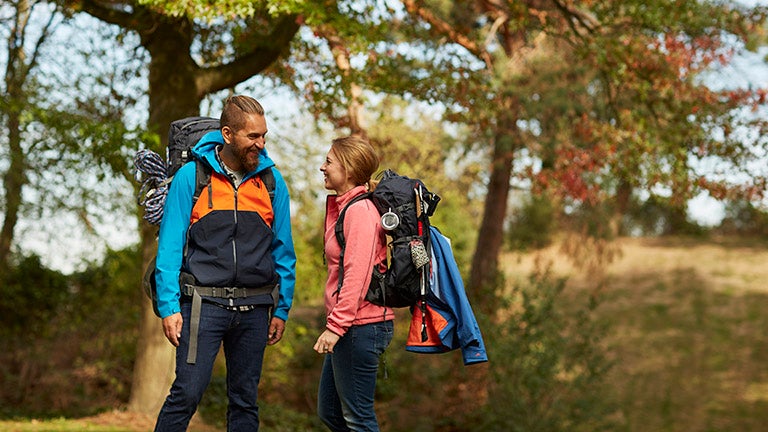9 easy ways to boost your walk


Improve your walk
When was the last time you put on your walking boots and roamed around in the fresh air? Walking is an all-round superstar when it comes to fitness and wellbeing, not least because it’s convenient, free and safe for any age or weight.
“Regular walking is not only a great way to spend time away from the worries of work while being active; it also has a whole host of associated health benefits,” says exercise scientist Johann Ruys.
If your usual walk isn’t enough of a workout anymore, challenge yourself by increasing the distance or intensity.
Here are 10 simple ways to boost the intensity of your walk:
1. Go faster
This one’s basic, but the challenge is to keep up your pace the whole time you’re walking and not slip back to a stroll. A faster walk is challenging at first, so aim to keep your pace up for 20 minutes initially, then gradually increase the duration.
2. Add high-intensity activities
Add high-intensity activities such as jogging, step-ups and star-jumps. Try 30-60 seconds every 5 minutes. Do these on a soft surface to reduce the impact on your joints.
3. Add intervals to your walk
Start small when adding intervals into your regular walking routine. “Try walking at a brisk pace from one tree to the next, then slow it down to a less intense pace as you walk past the next 3 or 4 trees,” says Ruys. Over time, he recommends you start to increase the intensity and duration of these interval periods, walking briskly for a whole street, or the duration of a song.
Boost bonus: Research from the University of New South Wales in Australia shows that interval training can produce greater weight loss results than exercising at a continuous, regular pace because it increases fat oxidation.
4. Switch your surface
Walk on the wild side! Keep boredom at bay by walking on different terrains: road, footpath, treadmill, grass, or shallow water if you're lucky enough to live near the beach. This works your body in slightly different ways and helps prevent repetitive overuse injuries, such as joint pain and shin splints.
5. Choose the stairs
Climbing stairs not only strengthens your glutes and legs; it can also use up to three times as much energy when compared to walking alone.
Exercise physiologist Neil Russell suggests trying this 30 minute workout: walk 5-10 minutes to the stairs, see how many flights you can do in 10-20 minutes, then finish off with another 5-10 minute flat walk. Each week or so, aim to conquer more flights in the same time.
To make it more challenging, take the stairs two at a time: front on activates the glutes, while facing sideways targets the inner and outer thighs.
6. Focus on your core
To stride at a swift pace you need good posture, and this starts with your core. Stand tall, keep your hips even and activate your abs by pulling your belly button inwards and towards your spine. Then squeeze your backside every time you plant your foot to take another step.
“You may find your posture wanes as you tire, so focus on readjusting throughout your walk – every few minutes – to ensure you’re making the most of your exercise,” says Russell.
Boost bonus: Focusing on your posture is good to do every time you walk but it can be difficult to remember! The more you do it, the stronger your core and joint stability will become, which will help you tread more efficiently and prevent injuries.
7. Add hills to your route
Choose a hilly walking route or adjust the incline on the treadmill to add intensity to your walk. “If there aren’t enough hills in your area, focus on finding one good-sized hill and break it into stages,” suggests Russell.
Walk for 5-10 minutes to arrive at the hill, go up and down for 10-20 minutes, resting every 4-5 minutes to do an upper body or core exercise (such as push-ups or sit-ups) for 60 seconds, then start walking again. Finish with a 5-10 minute flat walk.
Boost bonus: Walking uphill can use double the energy of walking on a level surface at the same pace.
8. Create a walking and strengthening circuit
Transform a simple stroll by adding muscle-building exercises to your routine. Russell recommends a 30-minute walk, stopping at the 10, 20 and 30-minute marks to complete one set each of 15 bench push-ups, 15 walking lunges on each leg, and a 1-minute plank.
Boost bonus: Not only will you have a great cardio workout, but you’ll also be building lean muscle mass.
9. Change your direction
“Change the direction of your walk for 20 steps at a time,” says Russell. “The safest place to do this is at your local track, so you know you’re on flat, soft ground.” Try walking backwards, sideways or on your tiptoes, then switch back to walking forwards for a few faster laps in between. Do this for 20-30 minutes.
Boost bonus: Moving in different directions targets often underused muscles (hamstrings, inner and outer thighs) and improves balance and stability. “Working these muscles helps prevent injuries and falls,” says Russell.
Remember to cool down by stretching after your walk.